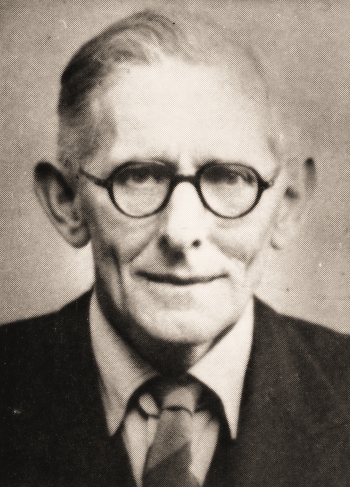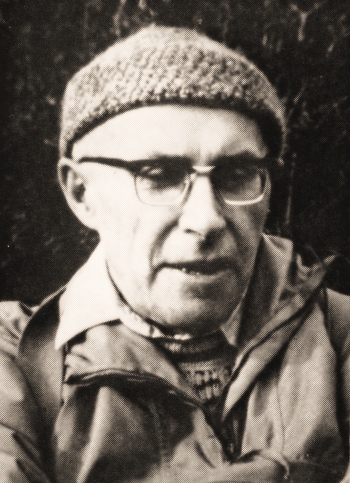In Memoriam
Frederick Singleton Booth
(1924-1972)
The Club suffered a great loss with the death of Fred Booth on 16th December, 1972. He joined in 1924 along with his brother Harold and was brought up in the best traditions of the Club. His father, Tom (T.S.) Booth, a member of the Club in its first year and President in 1930, was a member for over 40 years.
Fred gave unstinting service to the Club and was one in an outstanding line of Secretaries. He was a Committee Member from 1926 to 1946 and from 1954 to 1959, Assistant Secretary from 1926 to 1946, Secretary from 1946 to 1952 and Vice-President from 1952 to 1954. He was elected an Honorary Member in 1959, an honour of which he was immensely proud, but had to decline the Presidency owing to indifferent health.
Like Hazard and Smythe he began his climbing at Almscliffe Crag and Rocky Valley and became a very accomplished cragsman. Many new members have been glad of his friendly encouragement and guidance on their first climbs in the Lakes, on Tower Ridge or in the Alps.
In potholing he was keen and determined, always maintaining a sense of responsibility for safety. He was in the second party in Diccan to reach the top of the Alum Pot waterfall in 1925; one of the first to repeat Hensler’s crawl in Gaping Gill in 1938 and also in that year in the party which discovered Pollnagollum. He was in the team which redeemed a chapter of caving disaster in the Rowten Pot fatality in 1939.
Those who knew him well will always remember his quiet sense of humour, his strength of character, and his complete integrity, They will rejoice to have felt the warmth of his friendship.
S.M. B.N.
H.L.S. adds:
It was the first Y.R.C. Meet that my brother and I attended, we knew nobody and were rather shy, but by great good fortune we met Fred and Harold Booth. This was in 1933, and, although forty years is a long time, I remember to this day how they went out of their way to welcome us and draw us into the fold. The friendships then started matured during innumerable climbing and potholing jaunts.
Fred and Harold were members of a keen and accomplished group of climbers, which included C. D. Frankland, W. V. Brown, E. E. Roberts and Jack Hilton, whose customary Sunday exercise was to walk from the Leeds tram terminus at Lawnswood to Almscliff, climb all day and walk back in the evening, the best part of twenty miles plus the climbing. Frankland was dead, Brown and Roberts less active by the time we joined the Club but the habitual activity continued, almost every weekend at Almscliffe or Ilkley with an occasional venture to the Lakes or to Scotland. Nor was potholing neglected. Among many arduous trips I remember particulary the descent of Mere Gill during the King George V Jubilee weekend in 1935 when Fred, Roberts and I spent three whole days underground. I believe it was the third or fourth descent.
On my first climbing visit to the Alps Fred was one of the party. We went to Arolla, remote in those days. None of us had a great deal of Alpine experience, and, although we flogged ourselves hard and spent a prodigious number of hours on each expedition we were either too slow, too cautious or lost our way too often for we only got to the top of two peaks and crossed some passes.
One day on the South face of the Aiguille de la Tsa sticks in my mind. It was late afternoon, we had lost our way as usual and got into an area exposed to falling stones, and although we were not a long way from the top we decided to retreat. There was a lot of loose stuff and one large slab slid on to Fred’s leg and damaged it. We were young and impecunious and Fred’s main concern was to avoid the expense of being “rescued”. So a fast man (David Reed, I think) hurried down to explain that no help was needed, while the rest of us helped Fred who struggled down manfully. By 11 p.m. we reached the top of the woods and there was our fast man with coffee well laced with cognac. He had been down to Arolla and come up again. It was some of the best coffee I ever tasted; we had been out twenty-two hours.
Other Alpine holidays with Fred took us to the Maderanerthal and the Susten Pass area, and he was also very fond of the Pyrenees. On the hills he was a delightful companion—careful, reliable, but always eager to “have a go”. Moreover he was full of fun, and quick to see the amusing side of a situation however irritating.
One small incident is typical, I think, of Fred’s meticulous approach to everything he undertook. For some reason or another we decided to walk over forty miles on that particular day, and, having done so, we returned to my house for supper. I could see something was niggling Fred’s mind and it came out that he didn’t think we had gone far enough. So, after supper, we needs must turn out again and put in a few more miles for good measure.
His father (Tom) and Walter Parsons (of Parsons’ chimney fame) were next door neighbours. Their exploits in the potholing world are legendary and include, among many others, the discovery of the Booth/Parsons Crawl in Gaping Gill.
In 1946 Fred cemented the accord between the families by marrying Edith Parsons. After her death he married Rona Rennie, who shared his love of travel.
In recent years Fred had great trouble with his breathing and this made it almost impossible for him to walk up hills. But his interest in the Club never faltered, he managed to attend an occasional meet, and never failed to get to the Dinner.
He was buttoned-holed at the last Dinner by a young man who was writing a book on the history of caving and who wanted information about some of the old potholes. Fred was in his element. I can still see his animated face—alert, full of interest and repeatedly breaking into a smile. Within a month he was dead, but this is how his friends in the Club will remember him.
Our sympathy goes to his wife, Rona, and to his sister, Linda, and brother, Harold.
Arthur Leese
(1957 – 1972)
Arthur Leese was born in Newcastle-under-Lyme. After a brilliant career as a student at Cambridge and subsequently in research under J. B. S. Haldane, he first came to Yorkshire in 1931 to do Cancer research in Leeds. He became a house physician at the General Infirmary, left for more research at Oxford, and returned to Leeds General Infirmary as tutor a few months before the outbreak of war in 1939. During the war he was O.C. Medical Division of the Military Hospital in North Africa, returning afterwards to Leeds as Reader in Medicine. In 1950 he became consultant physician at St. James’s Hospital and three other Leeds Hospitals, and from then until his death he was fully and intimately concerned with the enormous expansion and re-building of St. James’s Hospital.
Outside his busy and onerous professional life he had a number of deep interests. First and foremost his family, with whom he spent much time in the Dales and in Scotland; then archaeology, an interest widened and enriched by his war service in Egypt and North Africa, and by subsequent holidays in these areas and in Turkey. And finally, mountain walking, ornithology and botany. He joined the Club in 1957 and was a regular attender at Meets and a very good goer over rough country. He rarely missed the Whitsuntide camps in Scotland. He had a great love for Scotland and returned with his family year after year to Sutherland. No member of the Club could rival his knowledge of eagles’ eyries in the North-West.
Following an incident in which a club guest was injured he was heard to say “It’s a pleasure to look after a man who carries his own triangular bandage”. But he went to great personal trouble to see that the man was properly looked after and as usual his kindness was hidden by superficial brusqueness, at the next Whit camp his tent was largely occupied by black bags full of medical supplies.
He was a shy, reserved man, very often silent when in a group. He was tolerant without concessions, and one was always aware of the underlying firmness. It was typical of him that few members of the Club were aware of his eminence as a physician. With his death the Club lost a devoted and loyal member.
A.B.C.

